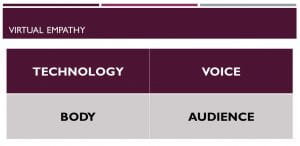LEE Gek Ling
Centre for English Language Communication (CELC)
Gek Ling discusses how colleagues can cultivate a strong teacher presence
to enhance student engagement in an online classroom.

Further to Choy and Ong’s (2020) reminder that online learning should target knowledge construction and development, how might engaging students be catalysed with teacher presence? Such presence in turn arises from performance. Classroom teachers are live or theatrical performers. However, in the Zoom classroom, TV or cinematic performance skills are needed. Attention to technology, voice, body and audience are more nuanced as the camera and microphone pick up every detail fed directly (not indirectly) into them (Duarte, 2020; Hishon, 2016). For further details, please see these slides.
Our students need to establish their own online presence when they need to make their presence felt online, whether in interviews, meetings, discussions or teleconferencing calls. Hence, I also taught my students these basic virtual empathy skills. A student who vlogged regularly (that is, maintained a video blog), then taught me to look sideways into the camera and to get a webcam with a mirror to check my own appearance to the viewer in order to establish stronger rapport through “eye contact”. A direct gaze into the camera can come across as being intimidating.
Along with others (Jiang, 2020), I found that my initial classroom dynamism would begin to flag as teaching online is more tiring. Nevertheless, a dynamic performance coupled with content knowledge can stimulate students and promote learning. As Lee (2020) notes, if student attrition is difficult enough to achieve during live lessons, it can become worse online. In a two-year study of 16 Australian universities offering online courses, Stone and Springer (2019) found that a strong teacher-presence online is of paramount importance. However, I also found, as did they, that teacher presence requires more than just having virtual empathy.
It also includes the virtual version of everything an engaging teacher does live. Stone and Springer (2019) recommend instructional videos of maximum eight minutes in length and embedded with exercises and activities, frequent and regular communication with the students by email post-lesson, especially with those flagged up from learning analytics as having incomplete or low scoring tasks. Holly King-Mand, an online teaching sensation who grew her followers from 74 to over 44,000 during the first month of the Covid lockdown in the UK, gives bite-sized English lessons, ‘shouts out’ periodically to attending students during her live stream videos, never leaves the screen, shows key learning points on A4 posters clipped onto a mini flipchart, sets two- to three-minute independent activities which students do while she plays the requisite interludes of instrumental music and attends to chat questions, and finally praises students extravagantly after each exercise (BBC News, 2020; King-Mand, n.d.). She also uploads optional extension exercises and invites students to post their work online if they so wish, which she appreciates in the next live lesson.
This playfulness, choice, connectedness with multimodal resources, collection of information from students about learning, and reciprocal communication taken from students are also factors that Chen and Yen (2004) found 16 years ago, that the quality of online presence could improve through interactivity. Although their original context referred to marketing presence, the application of these factors to online teacher-presence and increasing student engagement seems useful for further consideration.
To conclude, a strong online teacher-presence can be characterised by lively and interactive teacher-student relationships, which happen on camera through “TV” performance knowledge, optional learning extensions, as well as on-/off-camera follow-up and praise.
 |
LEE Gek Ling has taught at the chalk face at CELC for 30 years but is delighted now to learn how to teach online, proving that humans can outlast robots in deep learning over a longer time period. Gek Ling can be reached at elcleegl@nus.edu.sg. |
References
BBC News (2020, April 27). Coronavirus: English teacher ‘energised’ by lockdown learning. Retrieved from https://www.bbc.com/news/uk-england-beds-bucks-herts-52383295.
Chen, K., & Yen, D. C. (2004). Improving the quality of online presence through interactivity. Information and Management, 42(1), 217-226. https://doi.org/10.1016/j.im.2004.01.005.
Choy, J., & Ong, C. (2020, April 22). Supporting academics to teach remotely using Zoom [Teaching Connections blog post]. Retrieved from https://blog.nus.edu.sg/teachingconnections/2020/04/22/supporting-academics-to-teach-remotely-using-zoom/.
Duarte Inc. (2020, Mar 21). Virtual communication: Presenting with empathy [Webinar]. Retrieved from https://www.youtube.com/watch?v=3Ubx7uVSMqw.
Hishon, K. (2016, February 1). Stage vs. screen: A comparison of acting techniques [Theatrefolk blog post]. Retrieved from https://www.theatrefolk.com/blog/stage-vs-screen-a-comparison-of-acting-techniques/.
Jiang, M. (2020, April 23). The reason Zoom calls drain your energy. Retrieved from https://www.bbc.com/worklife/article/20200421-why-zoom-video-chats-are-so-exhausting.
King-Mand, H. (n.d.). English with Holly [Facebook page]. Retrieved from https://www.facebook.com/englishwithhollytutoring/.
Lee, K. (2020, March 10). Coronavirus: Universities are shifting classes online – but it’s not as easy as it sounds. Retrieved from https://theconversation.com/coronavirus-universities-are-shifting-classes-online-but-its-not-as-easy-as-it-sounds-133030.
Stone, C., & Springer, M. (2019). Interactivity, connectedness and ‘teacher-presence’: Engaging and retaining students online. Australian Journal of Adult Learning, 59(2), 146-169. Retrieved from https://www.ajal.net.au/downloads/interactivity-connectedness-and-teacher-presence-engaging-and-retaining-students-online/.


